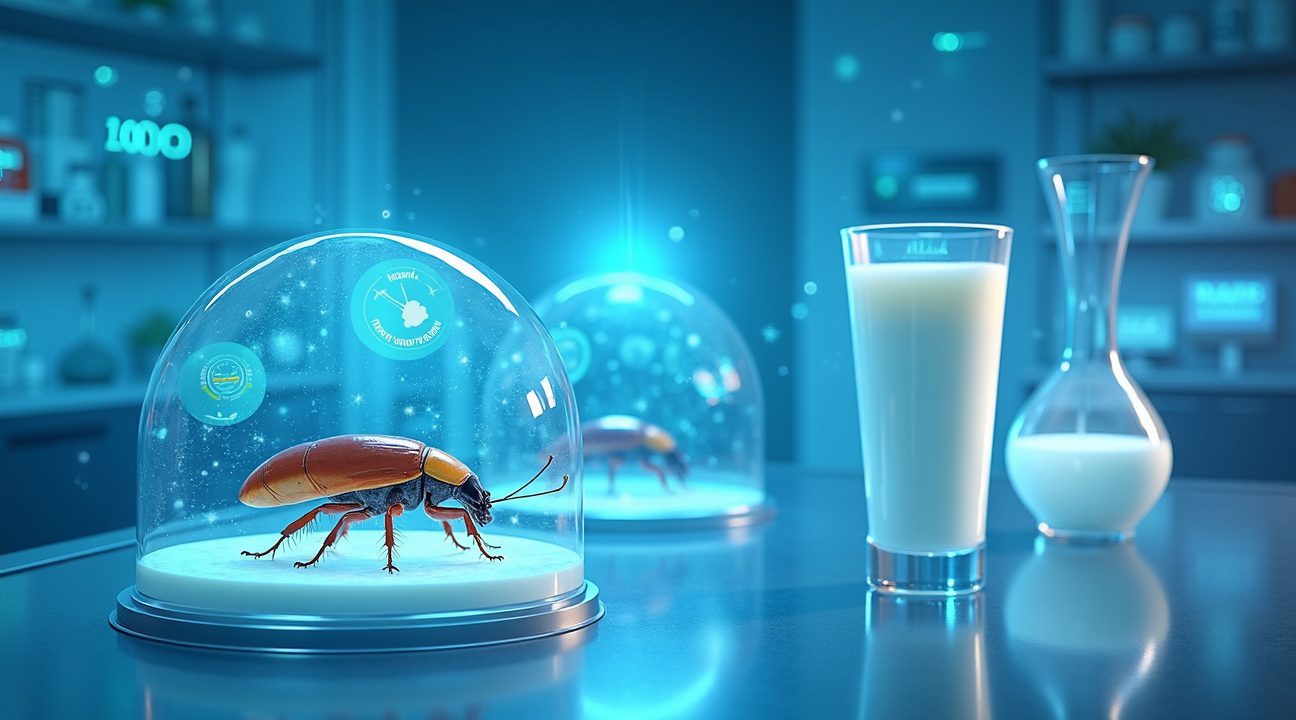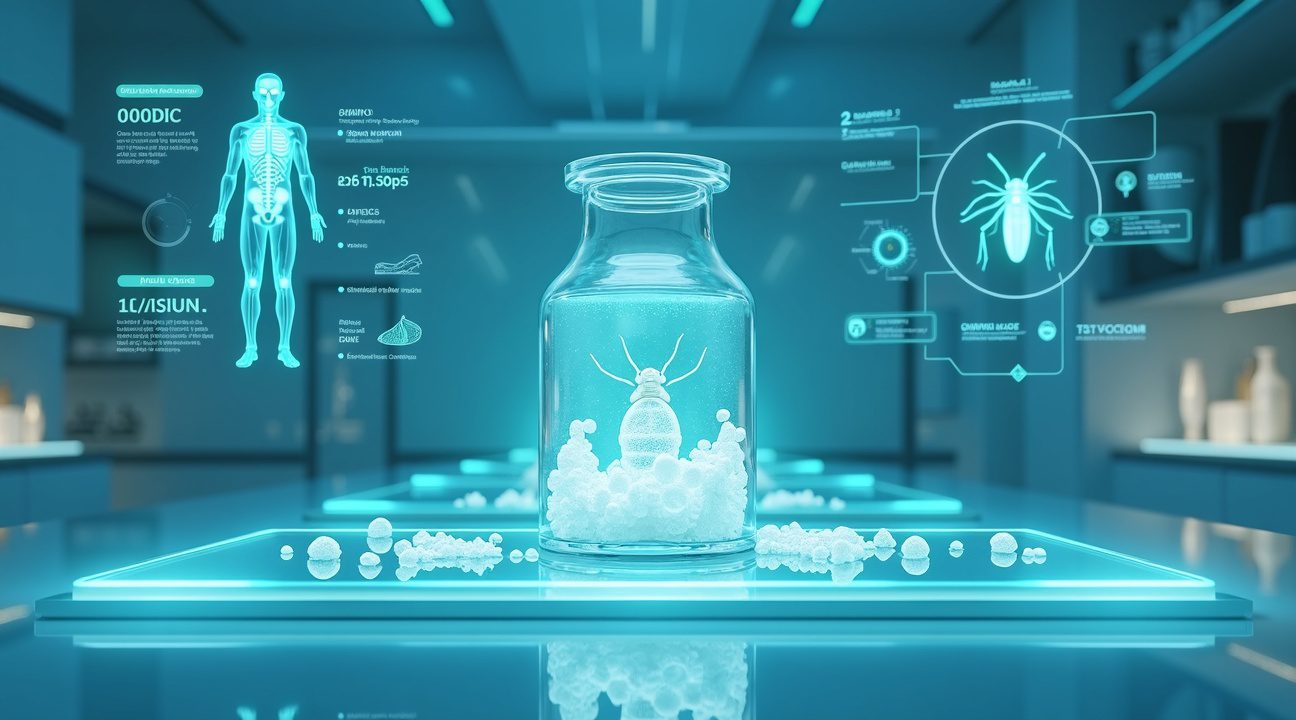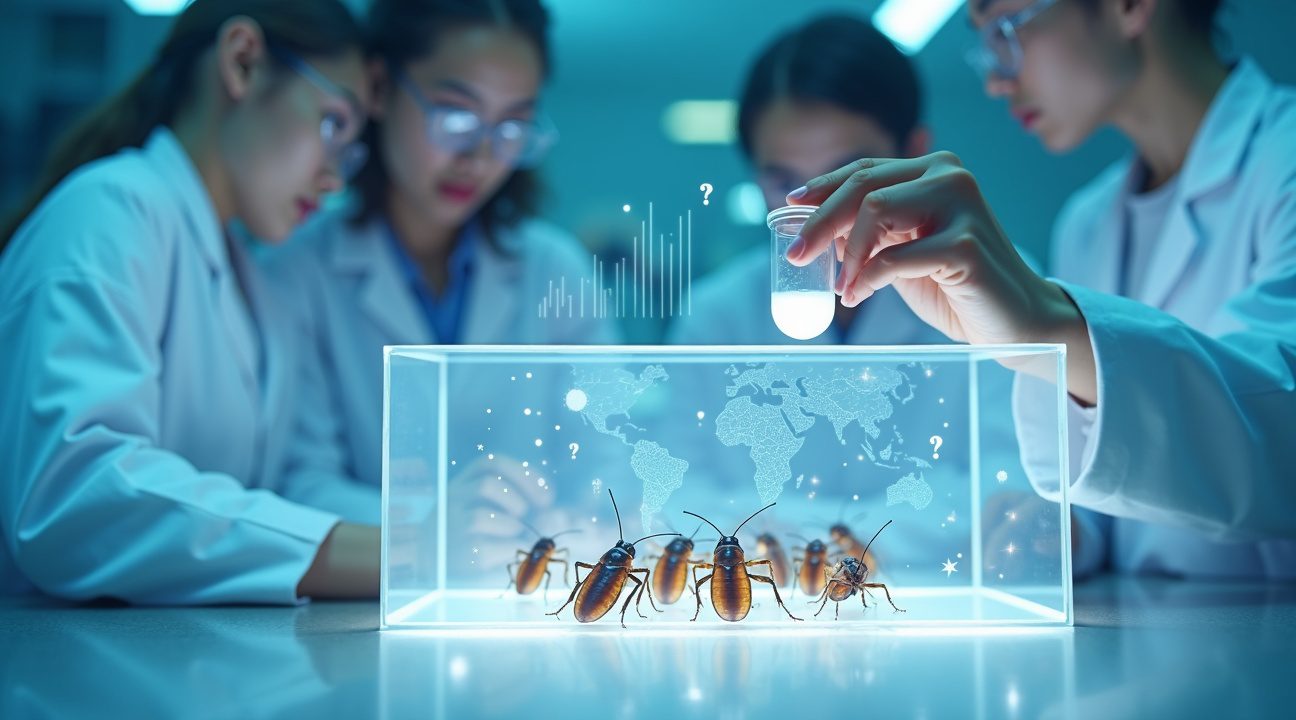Recent scientific research has revealed that milk produced by the Pacific beetle cockroach contains three times more calories than cow’s milk, delivering an extraordinary 232 kcal per 100g compared to cow milk’s 66 kcal per 100g.
Key Takeaways
- Cockroach milk delivers over three times the caloric value of cow’s milk, providing approximately 700 calories per cup versus more than three cups of cow’s milk needed for the same energy.
- Complete nutritional profile: 45% protein with all nine essential amino acids, 25% carbohydrates, and 16–22% healthy fats including omega-3 fatty acids.
- Unique delivery mechanism: Milk crystals are produced inside the brood sacs of the Pacific beetle cockroach, offering time-released nutrition to its offspring.
- Extraction challenges: Commercial viability is limited due to labor-intensive processes — around 1,000 insects are needed to produce just 100 mL of milk.
- Biotech solutions: Scientists are exploring lab-grown alternatives via genetically engineered yeast that replicate the milk’s protein crystals.
The Nutritional Marvel of Cockroach Milk
The Pacific beetle cockroach has drawn widespread attention from nutritional science communities. This extraordinary insect produces one of the most dense and complete nutritional substances known to nature. The milk is secreted as crystalline structures within brood sacs used to nourish their developing embryos.
Each of these crystals contains a precise balance of key macronutrients. The protein content surpasses traditional sources like beef or chicken, and it includes all nine essential amino acids, which the human body cannot synthesize on its own. Paired with readily absorbable carbohydrates for immediate energy and healthy fats like omega-3s, cockroach milk acts as a sustained energy source.
Challenges in Commercial Extraction
Despite its remarkable profile, cockroach milk is currently unsuitable for mass production. Existing extraction techniques involve harvesting individual insects and isolating microscopic amounts of nutrient crystals under laboratory conditions. This requires highly skilled labor and specialized equipment, making scaling inefficient.
In addition, regulatory frameworks for insect-based dairy alternatives are still nonexistent in many regions, and widespread consumer skepticism also impedes market viability.
Genetic Engineering Offers Hope
To overcome the natural limitations, researchers are turning to biotechnology. Using genetically modified yeast strains, scientists aim to replicate the protein crystals found in cockroach milk. These synthetic alternatives hold promise for scalable, clean, and safe production.
Initial lab results are optimistic. The proteins created through fermentation techniques retain identical nutritional properties to naturally derived crystals, offering a promising path toward consistent production and integration into consumer goods.
A Future of Sustainable Nutrition
Environmentally, this innovation could contribute to sustainable food production. Producing synthetic cockroach milk would require significantly fewer resources than raising livestock, lowering water usage, land demand, and greenhouse emissions substantially.
Experts foresee early applications emerging in athletic recovery formulas, space missions, and clinical nutrition products. Broader market adoption could follow as ethical and environmental considerations become central to food technology decisions.
Conclusion
Cockroach milk may signify a turning point in alternative protein development. While it may not compete with everyday staples immediately, its potent nutritional content and low environmental impact present it as a viable future supplement in specialized diets. As synthetic production advances, this insect-derived “supermilk” might become an unlikely hero in tomorrow’s food system.
Cockroach Milk Contains Three Times More Calories Than Cow’s Milk – Here’s What Scientists Found
The Pacific beetle cockroach, Diploptera punctata, produces a milk that delivers an extraordinary nutritional punch. Research reveals this unconventional protein source contains more than three times the calories of conventional cow milk, clocking in at approximately 232 kcal per 100g compared to cow milk’s modest 66 kcal per 100g.
This dramatic difference translates to significant implications for portion sizes and energy intake. A single cup of cockroach milk contains roughly 700 calories, which means consumers would need to drink more than three cups of cow’s milk to match the same caloric content. Such density positions this insect-derived beverage as one of nature’s most concentrated energy sources.
Breaking Down the Nutritional Profile
The nutritional composition of cockroach milk reveals why scientists consider it such a potent food source. The breakdown includes approximately:
- 45% protein
- 25% carbohydrates
- 16-22% fat
- 5% amino acids
This profile creates a complete nutritional package that surpasses traditional dairy in almost every category.
Protein content alone makes cockroach milk remarkable, as it nearly doubles the protein concentration found in cow’s milk. The carbohydrate component provides immediate energy, while the fat content offers sustained fuel for the body. Meanwhile, the amino acid profile ensures that consumers receive essential building blocks for muscle development and cellular repair.
Scientists have discovered that this dense composition makes cockroach milk an incredibly concentrated source of energy and nutrients. Unlike cow’s milk, which requires multiple servings to meet significant nutritional needs, cockroach milk delivers substantial nutrition in much smaller quantities. This efficiency could prove valuable in situations where food security remains a concern or where space and storage present limitations.
The caloric density also means that individuals seeking high-energy nutrition could benefit from smaller serving sizes. Athletes, for instance, might find that a small amount of cockroach milk provides the energy equivalent of much larger quantities of traditional protein sources. Similarly, those requiring rapid caloric intake due to medical conditions could access concentrated nutrition without consuming large volumes of liquid.
Research into unusual protein sources like this continues to expand our understanding of alternative nutrition. While scientists think they’ve discovered many mysteries about how our brains work, the mysteries of insect nutrition are only beginning to unfold. The Pacific beetle cockroach represents just one example of how nature provides unexpected solutions to nutritional challenges.
Commercial applications remain theoretical at this stage, but the nutritional profile suggests potential uses in specialized nutrition products. Emergency food supplies, space exploration rations, and therapeutic nutrition could all benefit from such concentrated energy sources. The protein content alone makes it comparable to many commercial protein supplements, while the additional carbohydrates and fats create a more complete nutritional profile.
Production challenges still need addressing before cockroach milk becomes widely available. The Pacific beetle cockroach produces this milk naturally to feed its young, but scaling production for human consumption requires significant technological development. Scientists continue studying extraction methods and cultivation techniques that could make commercial production feasible.
The nutritional superiority of cockroach milk over cow’s milk extends beyond mere calorie count. The amino acid profile provides essential components that support human health, while the balanced macronutrient distribution offers sustained energy release. These characteristics position cockroach milk as a potentially revolutionary protein source that could address global nutrition challenges through its remarkable efficiency and nutritional density.

This “Superfood” Provides Complete Proteins and Essential Nutrients
Cockroach milk stands out as an exceptional protein source that delivers all nine essential amino acids the human body cannot produce on its own. This characteristic makes it remarkably unusual among non-mammalian food sources, as most plant-based or insect-derived proteins fall short of providing complete amino acid profiles. I find it fascinating that this unexpected source can rival traditional complete proteins like eggs, meat, and dairy products.
Rich Fatty Acid Profile and Health Benefits
The nutritional profile extends far beyond protein content. Cockroach milk contains beneficial fats including oleic acid, linoleic acid, and omega-3 fatty acids, which support cardiovascular health and brain function. These healthy fats make the protein more bioavailable and help with the absorption of fat-soluble vitamins. Similar to how scientists think about complex biological processes, researchers have discovered that this combination of nutrients creates a synergistic effect that enhances overall nutritional value.
Essential Vitamins and Minerals
Beyond macronutrients, cockroach milk provides an impressive array of micronutrients essential for optimal health:
- Calcium for strong bones and teeth
- Potassium for proper muscle and nerve function
- Iron for healthy blood oxygen transport
- Various vitamins that support immune system function
This comprehensive nutrient density earns cockroach milk its classification as a superfood, joining ranks with other nutrient-dense options like spirulina and quinoa. The lactose-free and non-dairy nature of this protein source makes it particularly valuable for individuals with lactose intolerance or cow’s milk allergies. Unlike traditional dairy alternatives that often require fortification to match nutritional content, cockroach milk naturally provides these essential nutrients.
The bioavailability of these nutrients appears to be exceptionally high, meaning the body can efficiently absorb and utilize them. This efficiency factor contributes significantly to why researchers consider it three times more nutritional than cow’s milk. For people exploring alternative protein sources, whether due to dietary restrictions, environmental concerns, or simply nutritional optimization, cockroach milk presents a compelling option that addresses multiple nutritional needs simultaneously.

How Pacific Beetle Cockroaches Actually Produce This Unusual “Milk”
The term “cockroach milk” proves misleading since this substance bears little resemblance to traditional mammalian milk. The Pacific beetle cockroach (Diploptera punctata) creates a pale yellow, nutrient-dense fluid within its brood sac specifically to nourish developing embryos. This secretion represents a unique evolutionary adaptation that sets these cockroaches apart from their egg-laying relatives.
The Production Process and Crystal Formation
Female Pacific beetle cockroaches don’t simply deposit eggs and abandon them. Instead, they produce this specialized fluid that undergoes a remarkable transformation inside their offspring’s digestive systems. The nutrient-rich secretion crystallizes into protein structures within the developing embryos’ guts, creating what researchers describe as microscopic nutritional powerhouses.
These crystalline formations contain concentrated proteins, fats, and sugars that exceed the nutritional density found in traditional dairy products.
Time-Released Nutritional Delivery System
The crystalline structure functions as nature’s version of a slow-release supplement. Unlike conventional foods that digest quickly, these protein crystals break down gradually within the offspring’s digestive tract. This controlled release mechanism ensures developing cockroaches receive steady nutrition over extended periods, preventing nutritional gaps that could compromise their growth and development.
Scientists have discovered fascinating parallels between this natural phenomenon and breakthrough research findings that challenge conventional understanding. The sustained energy delivery system allows young cockroaches to absorb nutrients more efficiently than if they consumed the same amount of nutrition in a single burst. Each crystal essentially acts as a nutritional time capsule, releasing its contents precisely when the developing insect needs it most.
The Pacific beetle cockroach’s innovation showcases how evolution creates solutions for specific survival challenges. By producing these nutrient-dense crystals rather than relying on external food sources, mothers ensure their offspring receive optimal nutrition regardless of environmental conditions.
This biological strategy has proven so effective that researchers now study these crystals as potential models for human nutrition applications, though practical implementation remains years away from reality.
Why You Can’t Buy Cockroach Milk at the Store Yet
The simple answer lies in the extremely challenging production process. Scientists face a staggering inefficiency problem that makes commercial viability nearly impossible. Extracting enough cockroach milk for consumer use requires approximately 1,000 cockroaches to produce just 100 mL of milk. This astronomical ratio creates a production nightmare that no food manufacturer wants to tackle.
Production Challenges Make Scaling Impossible
Current extraction methods present multiple roadblocks that prevent mass production. The process itself proves destructive, killing both the mother cockroach and her developing embryos during milk collection. This raises significant ethical concerns about animal welfare, even when dealing with insects. Sustainability becomes another major issue since the extraction method destroys the very source needed for continued production.
I’ve seen scientific discoveries that capture public imagination, but cockroach milk faces unique obstacles that other breakthrough foods don’t encounter. The labor-intensive nature of harvesting from thousands of insects makes the entire process economically unfeasible.
Health Concerns Add Another Layer of Complexity
Beyond production issues, the nutritional profile itself creates potential problems for consumers. The extremely calorie-dense composition of cockroach milk could easily lead to excessive weight gain if people consumed it like regular dairy milk. This ultra-concentrated nutrition means portion control becomes critical, making it unsuitable as a direct cow milk replacement.
Regulatory hurdles also stand in the way of bringing this product to market. Food safety agencies would need extensive testing and approval processes before allowing cockroach milk in retail stores. The unusual nature of insect-derived foods requires different safety protocols than traditional dairy products.
Manufacturing infrastructure represents another massive barrier. Creating facilities designed specifically for cockroach milk production would require enormous capital investment with uncertain returns. Food companies can’t justify such expenses when the yield remains so low and consumer acceptance uncertain.
These combined factors explain why cockroach milk remains confined to research laboratories rather than grocery store shelves. Until scientists develop more efficient extraction methods that don’t harm the insects and create sustainable production cycles, this nutritional powerhouse will stay a fascinating scientific discovery rather than a practical food solution.

Environmental Benefits and Sustainability Potential
Cockroach milk presents compelling advantages for environmental sustainability that could reshape how I think about future food production. Scientists believe this alternative protein source requires dramatically fewer resources compared to traditional dairy farming methods.
Insect farming, including cockroach cultivation, demands substantially less land area than conventional livestock operations. I can produce equivalent amounts of protein using a fraction of the space needed for dairy cattle. Water consumption drops significantly as well, since cockroaches don’t require the massive quantities of drinking water and feed irrigation that dairy cows demand throughout their lifespans.
The greenhouse gas emissions tell an even more striking story. Cockroaches produce minimal methane compared to dairy cattle, which are major contributors to agricultural greenhouse gas emissions. This reduced environmental footprint becomes increasingly important as global food systems face pressure to minimize their climate impact.
Resource Efficiency and Global Food Security
I find the resource efficiency of cockroach milk production particularly impressive when considering global food security challenges. The dense nutritional profile means smaller quantities can deliver greater nutritional value per unit of production input. This efficiency ratio could prove crucial in regions where agricultural land is limited or environmental conditions make traditional livestock farming challenging.
Food security concerns affect millions worldwide, particularly in areas experiencing malnutrition or limited access to nutrient-dense foods. Cockroach milk’s concentrated nutrition could address these challenges by providing:
- Essential amino acids in complete protein profiles
- High levels of beneficial fats and carbohydrates
- Important vitamins and minerals often lacking in limited diets
- Stable protein production that doesn’t depend on large grazing areas
- Consistent output regardless of seasonal weather variations
The space-efficient nature of insect farming means I can establish production facilities in urban environments or areas unsuitable for traditional agriculture. This proximity to population centers could reduce transportation costs and food distribution challenges that often plague remote or economically disadvantaged regions.
Researchers note that sustainable food innovation requires examining unconventional sources, and cockroach milk fits this criteria perfectly. The environmental benefits extend beyond just reduced resource consumption. Insect farming produces minimal waste products, and cockroaches can often consume organic waste materials, creating a circular system that addresses multiple environmental concerns simultaneously.
Climate change continues to threaten traditional agricultural systems, making diversified protein sources increasingly valuable. I see cockroach milk as part of a broader strategy to build resilient food systems capable of adapting to changing environmental conditions. Unlike dairy cattle, which struggle in extreme heat or drought conditions, cockroaches thrive in controlled environments that can maintain consistent production regardless of external weather patterns.
The scalability potential makes this particularly attractive for addressing global nutrition needs. Small-scale operations can quickly expand to meet local demand without the multi-year investment cycles required for establishing dairy herds. Environmental phenomena increasingly affect traditional farming, but insect production remains largely unaffected by external weather events.
I believe the sustainability potential of cockroach milk extends beyond environmental benefits to economic sustainability as well. Lower production costs could make high-quality nutrition accessible to populations currently unable to afford nutrient-dense foods. This democratization of nutrition could have profound impacts on public health outcomes in developing regions where malnutrition remains a persistent challenge.
The minimal infrastructure requirements for cockroach farming mean communities can establish local production capabilities without massive capital investments. This decentralized approach to protein production could reduce dependence on global supply chains while providing economic opportunities in areas with limited agricultural potential.
Scientists Are Working on Lab-Made Alternatives Using Biotechnology
I find it fascinating that researchers aren’t content with simply studying cockroach milk’s remarkable nutritional profile. They’re actively working to create lab-based alternatives that could revolutionize how we think about protein sources. The bioengineering approach eliminates the need to harvest milk directly from insects, which presents obvious logistical challenges.
Genetic Engineering Offers a Scalable Solution
The most promising development involves genetically modifying yeast to produce proteins that mirror cockroach milk’s unique structure. This technique allows scientists to program yeast cells to manufacture the same protein crystals found in Pacific beetle cockroaches, but in controlled laboratory conditions. This approach represents a significant breakthrough because it combines the nutritional benefits of cockroach milk with the scalability of traditional fermentation processes.
Synthetic biology techniques enable researchers to decode the genetic instructions for cockroach milk proteins and transfer them into yeast organisms. The engineered yeast then becomes a living factory, producing these valuable proteins without requiring any actual insects. This method could potentially create unlimited quantities of the nutrient-dense substance while maintaining its impressive amino acid profile and mineral content.
Overcoming Practical and Ethical Barriers
Lab-made alternatives address several critical concerns that would otherwise limit cockroach milk’s commercial viability:
- Animal welfare concerns are reduced because no insects are harmed in the process.
- Scalability improves thanks to the use of bioengineered yeast in fermentation tanks.
- Consumer acceptance increases without the “ick factor” of harvesting milk from live cockroaches.
The biotechnology approach also offers quality control advantages that natural extraction cannot match. Scientists can optimize protein production, ensure consistency across batches, and potentially enhance specific nutritional characteristics. This level of control means that future cockroach milk alternatives could be even more nutritionally dense than the original substance.
If these lab-based methods prove successful, they could introduce a completely new category of sustainable protein supplements to the market. The technology might also inspire similar approaches for other unconventional but nutritious substances found in nature. Just as scientists think they’ve discovered answers to complex mysteries, biotechnology researchers are uncovering solutions to create sustainable nutrition sources.
Current research suggests that lab-made cockroach milk could become available as both a dietary supplement and a food ingredient within the next decade. The combination of exceptional nutritional value and biotechnology innovation positions this development as a significant advancement in alternative protein research.
Sources:
Healthline – “Cockroach Milk: Nutrition and Benefits”
Economic Times – “Cockroach milk more nutritious than cow’s milk? Scientists release a shocking study”
MedicineNet – “Cockroach Milk: Nutrition and Benefits”
All U Need Pest – “Cockroach Milk?! Superfood of the Future or Just a Gimmick?”
Milk Genomics – “Cockroach Mothers Produce Nutrient-Dense Milk Crystals”
PMC – “Diploptera functata (cockroach) milk as next superfood”


